10 – 22 MAY 2024
By Dominic Rollinson
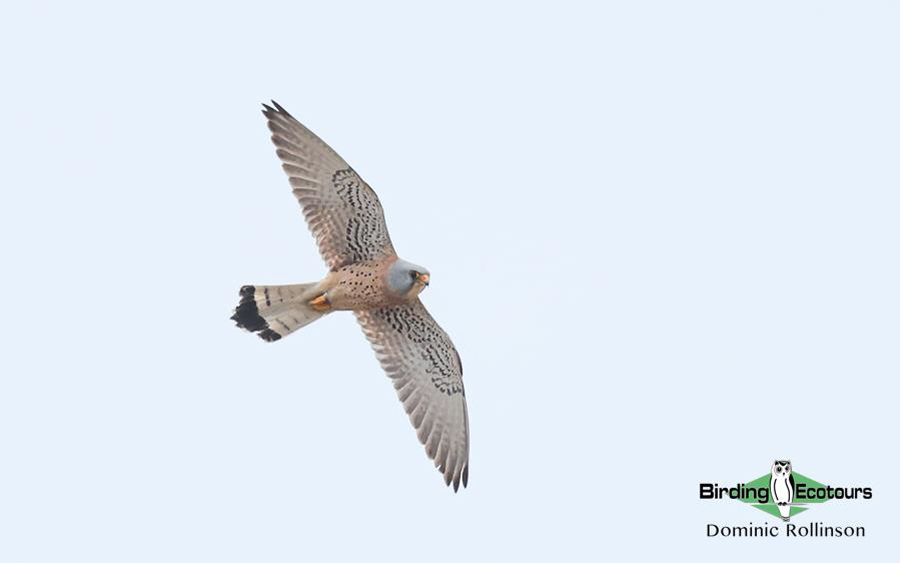
Lesser Kestrel was one of the many lovely spring migrants that we saw on this tour.
Overview
This Bulgaria and Romania birding tour was timed to enjoy the impressive spring migration of birds returning from their (mostly African) non-breeding grounds, while we also took in a host of resident bird specials and spent time in the massive Danube Delta. The peak of the migration was a little earlier than usual this year which meant we missed some species, however, it also meant that other species were already well-established on their breeding grounds, and we enjoyed seeing and hearing birds defending breeding territories often providing us with lovely views.
This tour started in Bulgaria’s capital, Sofia, before heading south to bird the Rhodope Mountains (where we even enjoyed the last patches of snow in the highest areas) and we found specials such as Corn Crake, Cinereous Vulture, Eastern Imperial Eagle, Lesser Kestrel, Wallcreeper, Black, Middle Spotted and Lesser Spotted Woodpeckers, Sombre and Crested Tits, Masked Shrike, Eastern Subalpine Warbler, Barred Warbler, Rock Bunting and many others. While birding in the Rhodope Mountains we were lucky enough to see Northern Chamois – a striking-looking mountain goat!
From the eastern Rhodope Mountains we carried on eastwards to the Black Sea coast where we enjoyed some fantastic coastal and wetland birding with highlights including Dalmatian Pelican, Garganey, Spotted Redshank, Eurasian Penduline Tit and Bearded Reedling.
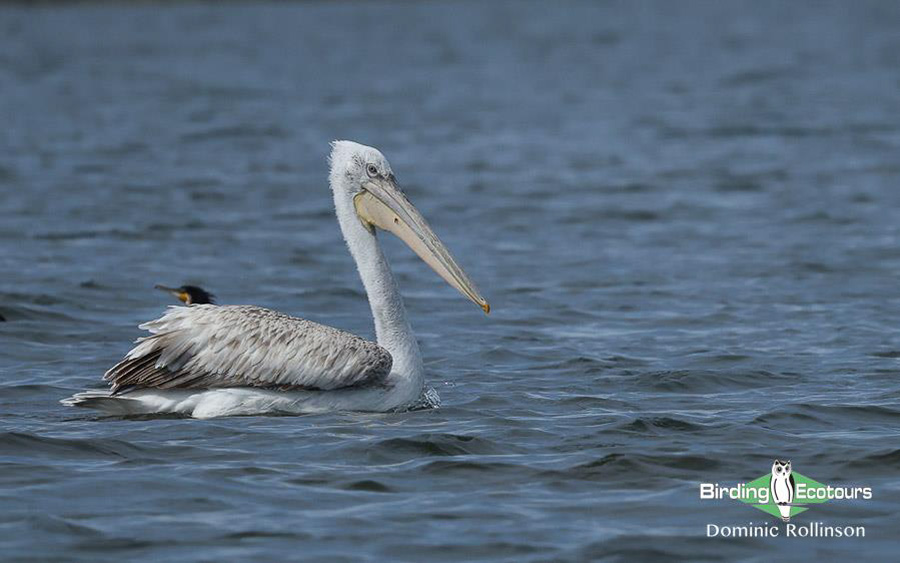
Huge Dalmatian Pelicans were abundant in wetlands of Bulgaria and Romania.
All along the Black Sea coast the area was full of passage or breeding migrants which was a delight to see. Some of the commoner migrants included Western Marsh Harrier, Short-toed Snake Eagle, Eurasian Hobby, Eurasian Golden Oriole, Woodchat and Red-backed Shrikes, Common Nightingale, European Roller and European Bee-eater. Cape Kaliakra and the surrounding area was particularly rewarding for migrants such as Black-throated Loon, Red-breasted Flycatcher, Pied Wheatear, Whinchat, Tawny Pipit, Western Yellow Wagtail and Calandra Lark.
We then crossed into Romania where the excellent birding continued, and we even managed to find a Romanian rarity in the form of Pectoral Sandpiper. Other highlight species here included Red-footed Falcon, Ruddy Shelduck, Grey Partridge and Ortolan and Black-headed Buntings.
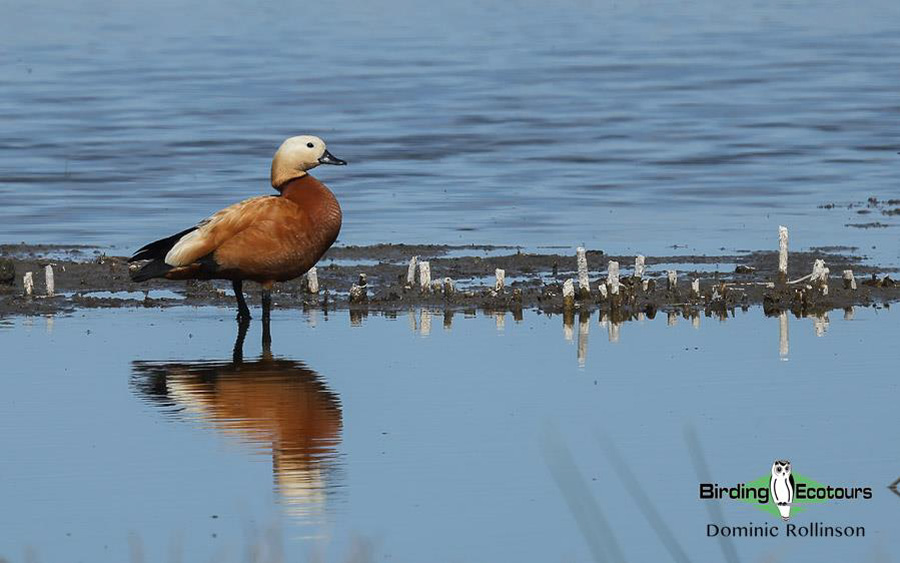
We had several sightings of Ruddy Shelducks in waterbodies near to the Black Sea.
Next up was the massive Danube Delta where we spent a full day out on a boat enjoying the likes of White-tailed Eagle, Dalmatian Pelican, Pygmy Cormorant, Red-necked Grebe, Eurasian Spoonbill, Black Tern, Pallas’s and Caspian Gulls and Bearded Reedling. We never tired of working our way through large groups of waterfowl where we picked out Garganey, Eurasian Wigeon, Ferruginous Duck and Northern Shoveler.
The adventure ended with a day in the Vadu area which was just full of birds. Some of the standout species here included Eurasian Bittern, Red-crested Pochard, Collared Pratincole, Paddyfield and Savi’s Warblers and huge numbers of waterfowl and other water bird species. We then made our way to Bucharest (adding Levant Sparrowhawk at one of our final stops) where the tour ended after a highly enjoyable two weeks in the Balkans.
Detailed Report
Day 1, 10th May 2024. Mount Vitosha birding, transfer to the western Rhodope Mountains
Vickie and I met Dancho (our Bulgarian guide and driver), who had fetched Melanie from the airport, at our lovely accommodation in Sofia and we immediately made our way up Mount Vitosha, which sits above the capital city. Unfortunately, the weather was grim and the higher we went, the thicker the fog got! We soon arrived at our birding spot and braved the cold conditions (with limited visibility) and managed to eke out a few nice birds. The normally reliable Spotted Nutcrackers would not show for us today, but we did find Common Firecrest, Eurasian Wren, Ring Ouzel, Dunnock and Yellowhammer.
We then headed back down Mount Vitosha and steadily made our way south and into the western Rhodope Mountains. Before reaching the mountainous areas with their tall conifer forests, we birded some farmlands where we had superb views of a calling Corn Crake and also got our first looks at Common Woodpigeon, Common Cuckoo and Corn Bunting.
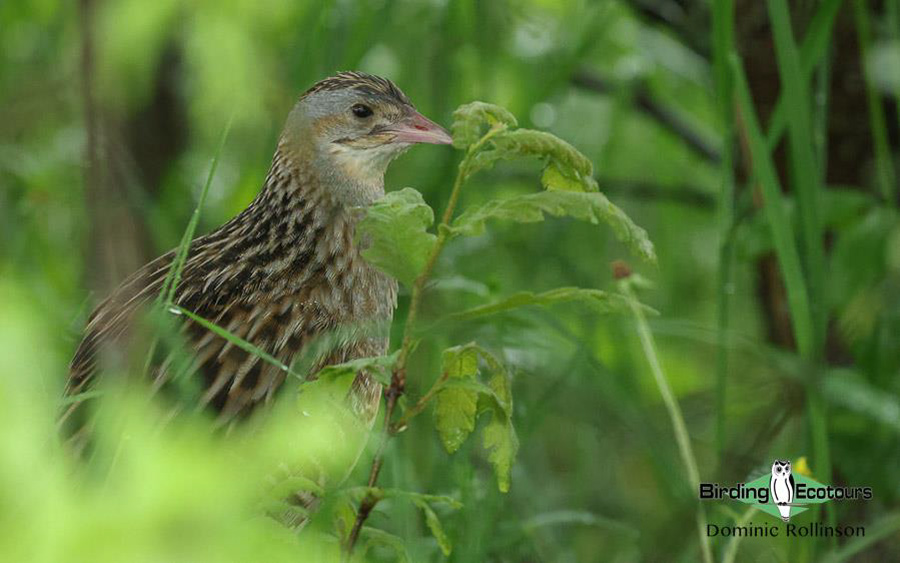
The tour started with a bang with this showy Corn Crake.
At our lunch stop (good old KFC) we got our first taste of some of the commoner migrants including Western Marsh Harrier, Common Swift, Barn Swallow and Western House Martin, as well as a few singing European Greenfinch and European Goldfinch.
We then started climbing again and birded a nice patch of pine forest which held Great Spotted and Eurasian Green Woodpeckers, Coal and Crested Tits, Song Thrush and another Common Firecrest. Today had mostly been a travel day but we’d still squeezed in some fine birds!
Day 2, 11th May 2024. Birding Trigrad Gorge and the western Rhodope Mountains
We started the day with a rather chilly pre-breakfast walk around the hotel grounds which turned out to be quite bird-rich and we soon saw Pallid Swift, Common Cuckoo, Mistle Thrush, Spotted Flycatcher, Eurasian Bullfinch and Red Crossbill.
After breakfast we checked out of our hotel and started the drive towards Trigrad Gorge. After a few minutes Dancho pulled in at a known Black Woodpecker spot and, before we knew it, we had great looks at this massive woodpecker. With the sun out, we had some nice raptors overhead including European Honey Buzzard, Common Buzzard and Eurasian Sparrowhawk. From here, the drive proved to be a beautiful one as we drove through large gorges and along fast-flowing rivers. A couple riverside stops produced White-throated Dipper, while passing through the many small towns en route added breeding White Stork and Black Redstart.
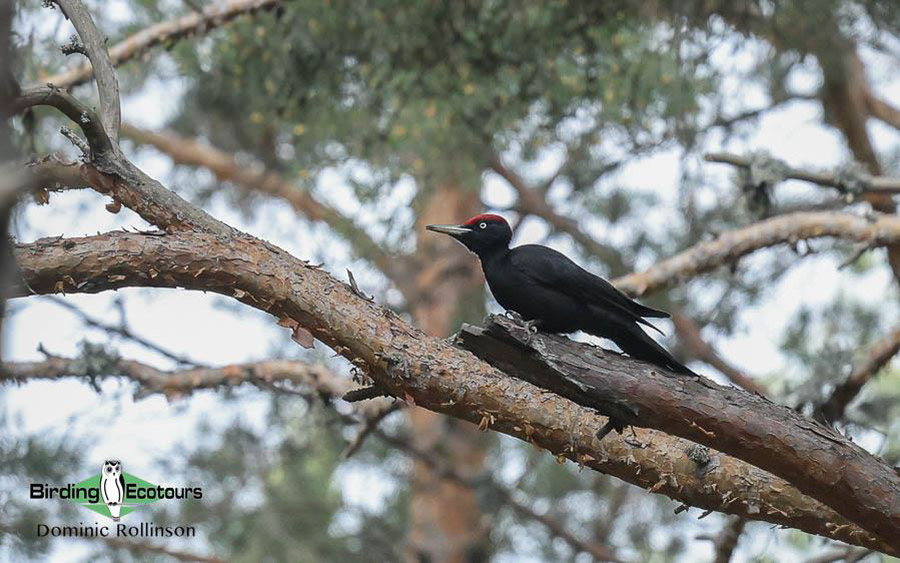
The large and distinctive Black Woodpecker showed well for us.
We arrived at Trigrad Gorge in the late morning and started the vigil to find Wallcreeper, a monotypic family. After scanning the tall cliffs for a while, we decided to give it a break and take our lunch break a bit earlier. The lunch was great (fish and chips) and we enjoyed a nice distraction in the form of a Willow Tit. After lunch we decided to bird some open areas nearby, which was a welcome break from staring at the cliffs. Here, we added Eurasian Crag Martin, Red-rumped Swallow, Grey and White Wagtails and European Serin.
It was then back into the gorge where we spent a couple more hours scanning for Wallcreeper. We were just about to give up when we spotted some movement high up on the cliffs and then enjoyed prolonged, although distant, scope views as a Wallcreeper scurried about on the sheer cliffs. Relief!
In the mid-afternoon, we arrived at our lovely accommodation set in the extremely picturesque village of Yagodina and decided to take it easy for the remainder of the day.
Day 3, 12th May 2024. Birding the Rhodope Mountains
An early morning walk around town produced more nice sightings of previously seen species and Vickie did well to spot a Northern Chamois, a wild mountain goat, which proved to be the only sighting of the trip.
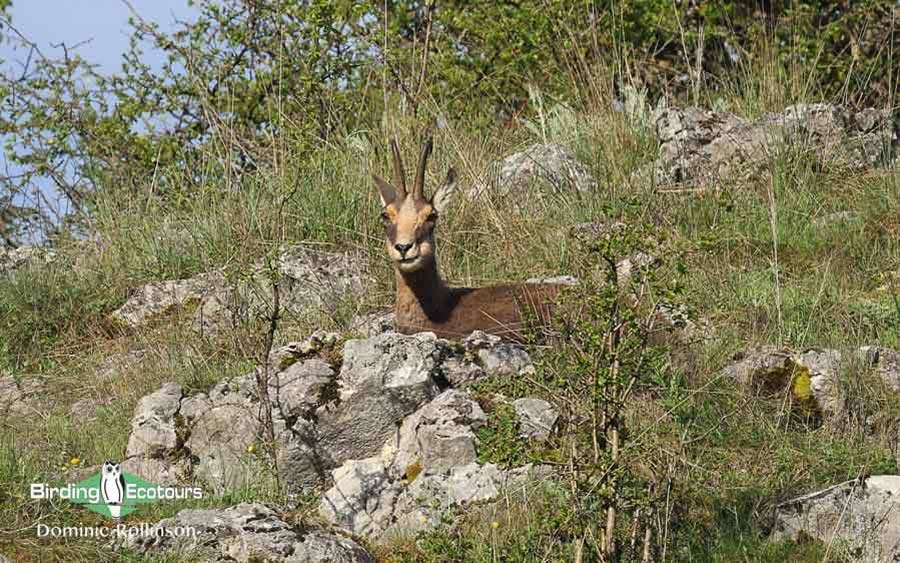
This Northern Chamois watched us in the hills above town.
After breakfast, we packed our bags and hit the road again. We made our way along the Rhodope Mountains for most of the morning and stopped off at a spot where Spotted Nutcracker is sometimes seen. We heard them calling soon after arriving and I managed brief flight views but unfortunately the birds disappeared and that was the end of the nutcracker show. We continued birding the general area and climbed higher into the mountains, where we saw large areas of snow-covered ground which had not yet melted from the winter. Other nice species seen as we made our way through the mountains included White-throated Dipper, Grey Wagtail, Black Stork and Ring Ouzel.
Before arriving in Krumovgrad in the late afternoon, we stopped at a small patch of trees alongside a river, which proved to be an incredibly productive hour or so of birding. Here, we quickly found Short-toed Treecreeper, Middle Spotted, Lesser Spotted and Eurasian Green Woodpeckers, Eurasian Golden Oriole (our first of many), Icterine Warbler, Eurasian Blackcap, Eurasian Tree Sparrow and Short-toed Snake Eagle. Nearby we found our first Cirl Bunting of the trip. We then arrived in Krumovgrad in the late afternoon where we enjoyed the remainder of the afternoon at leisure.
Day 4, 13th May 2024. Birding the eastern Rhodope Mountains
The change in vegetation was quite noticeable here in the eastern Rhodope Mountains; a much drier and sparsely vegetated environment compared to the tall forests of the western Rhodope Mountains. The change in habitat of course meant a change in bird species on offer and we racked up a good selection of new species today. We started our day with a walk along the Krumovgrad River, where we easily found Little Ringed Plover, Black and White Storks, Syrian and Black Woodpeckers, Eurasian Hobby, Lesser Grey Shrike, Eastern Olivaceous Warbler, Barred Warbler, Common Whitethroat, Common Nightingale and Black-headed Bunting.
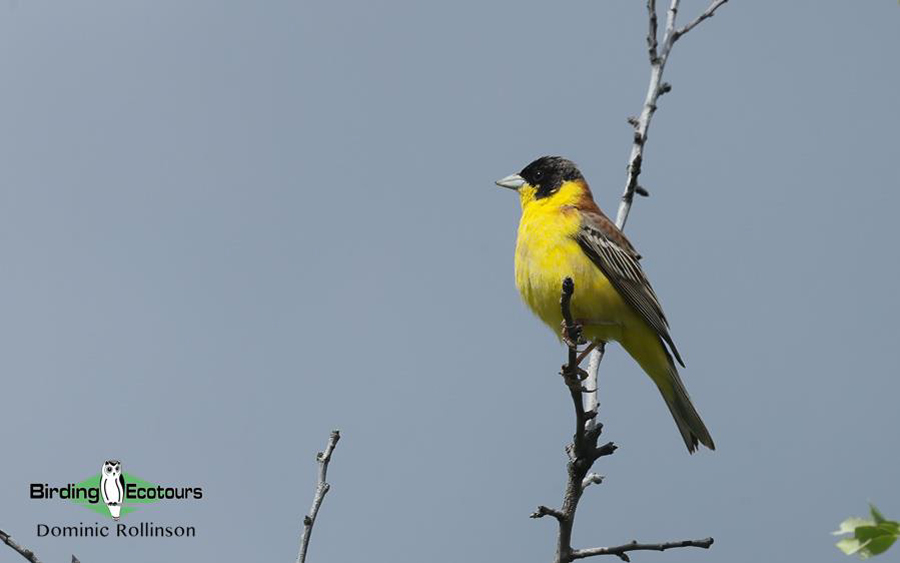
Black-headed Buntings were common in the eastern Rhodope Mountains.
After our breakfast we headed out for the remainder of the day and spent most of the day in the Madjaraovo volcanic region. One of our first stops was a viewpoint where vultures are regularly seen and, within a few minutes of arriving, we saw Griffon, Cinereous and Egyptian Vultures as well as Booted Eagle, Short-toed Snake Eagle, Common Kestrel and Common Raven. Another stop in some nearby woodland further added Great Spotted Woodpecker, Woodchat Shrike, Sombre Tit and Marsh Warbler (after much effort, we managed to get satisfactory views and Melanie managed to fire off a few pics).
We then stopped at a nearby rocky outcrop to see if we could find the scarce Western Rock Nuthatch. Despite Dancho showing us its nest hole, the birds were unfortunately not around today and instead we had to settle for Eastern Subalpine Warbler, Blue Rock Thrush, Eastern Black-eared Wheatear and Ortolan Bunting. Next, we stopped off at the nearby conservation center for lunch, it was interesting to see the vulture display and learn a bit more about their conservation in the area.
After lunch we had another go at the nuthatches, this time at the traditional Madzharovo Crater area, where we spent a while birding the boulder-strewn slopes hoping for the nuthatch. Yet again, we drew a blank on the nuthatch, but we did find Griffon Vulture, Booted Eagle, Eurasian Hoopoe, Peregrine Falcon, Blue Rock Thrush and Rock, Cirl and Ortolan Buntings.
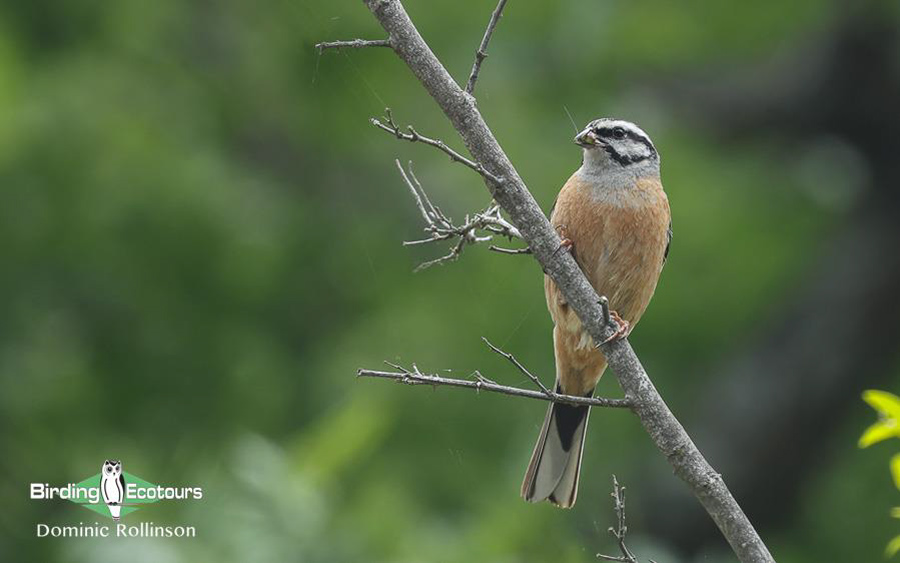
This Rock Bunting put on a show for us at the Madzharovo Crater.
We then moved around the corner to the Ivaylovgrad Reservoir and the surrounding area, which was full of birds. Dancho got very excited en route when he spotted a Masked Shrike, which saved us a detour a couple of days later. At the reservoir itself we found Great White Pelican, Black Tern, Squacco Heron, Eurasian Oystercatcher, Little Ringed Plover, Ruff, Curlew Sandpiper, Little Stint and a slightly out-of-habitat Sanderling. In the surrounding area we added European Turtle Dove, European Bee-eater, European Roller, Woodchat Shrike, Spanish Sparrow and Western Yellow Wagtail. Dancho’s sharp eyes picked out our first Little Owl of the trip which was sat on top of a ruined building. A final stop back at Madzharovo Crater still did not yield the hoped-for nuthatches and so we decided to head back to Krumovgrad after a wonderful day’s birding.
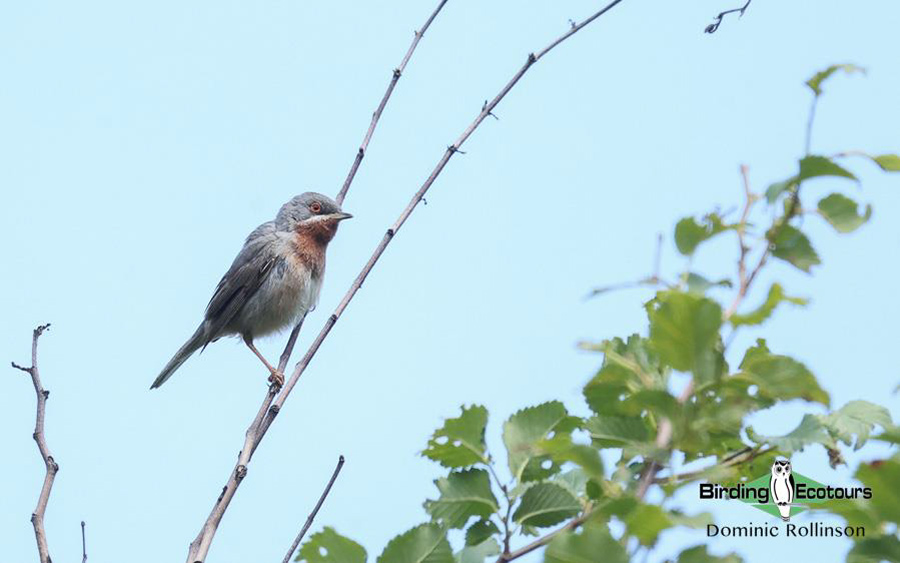
Eastern Subalpine Warblers were abundant in the eastern Rhodope Mountains.
Day 5, 14th May 2024. Further birding in the eastern Rhodope Mountains
Another early morning walk along the Krumovgrad River produced much of the same diversity as yesterday’s walk, although we had better looks at Eurasian Golden Oriole and Eastern Olivaceous Warbler this morning.
After breakfast we again headed out for most of the day and started birding some scrubby areas near Potochnica village, where we saw Egyptian and Griffon Vultures, Olive-tree and Sardinian Warblers and Yellowhammer. The warblers took some effort to see but we eventually managed decent looks at them. Amazingly, Melanie even managed a photo of the Olive-tree Warbler as it dashed between bushes.
A nearby vulture restaurant turned out to be the source of all the vulture activity and we further added Cinereous Vulture to the day list and also saw Black Kite here. The nearby scrub held Eurasian Hoopoe, European Roller, Woodlark, Common Whitethroat, Eastern Subalpine Warbler and European Goldfinch.
Our lunch stop was a peaceful, shady spot along a river which we thought looked perfect for White-throated Dipper and, sure enough, a pair of these cute birds flew by as we were finishing up lunch.
We spent the rest of the afternoon birding various rocky ridges and patches of scrub which held more of the same as earlier in the day, while a stop along the Arda River added Common Kingfisher, Eurasian Nuthatch and Long-tailed Tit. We had still not had any luck with Chukar Partridge and it was starting to look like we might dip, but then Melanie somehow spotted a dot on the horizon, which turned out to be our target partridge. Other nice birds seen near the Krumovitsa River included European Roller, Eastern Subalpine Warbler, Eastern Black-eared Wheatear and Cirl Bunting.
Later that evening, after dinner, we took a walk to a nearby park which produced the hoped-for Eurasian Scops Owl within a minute of starting our search. The whole operation took about 15 minutes, from leaving our hotel to getting back to our hotel!
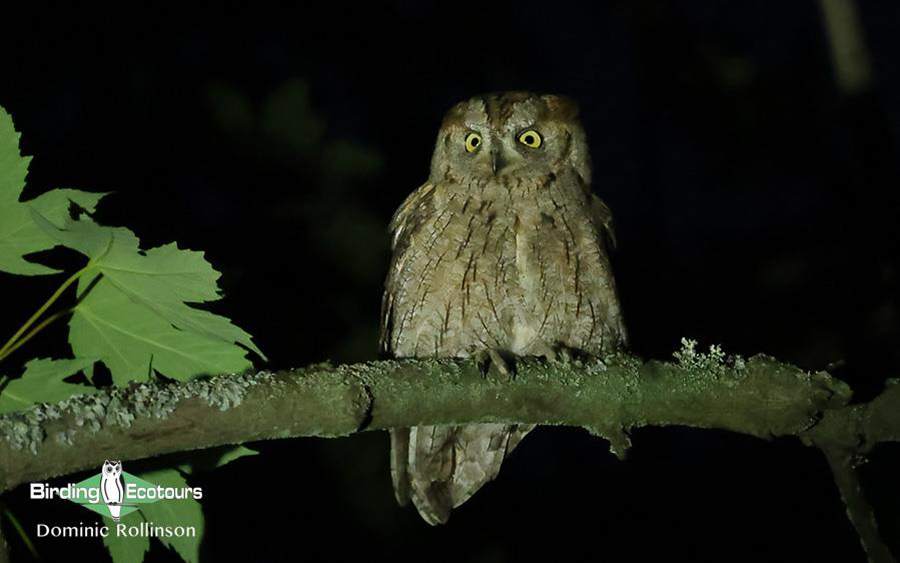
Eurasian Scops Owl proved easy to locate in Krumovgrad.
Day 6, 15th May 2024. Birding the eastern Rhodope Mountains to the Black Sea coast
Before reaching the Black Sea coast we had some important birds to find as we left the Rhodope Mountains. Highest on the agenda were a bunch of raptor species, and birding the slopes of the mountains gradually added Long-legged Buzzard, and Eastern Imperial and Lesser Spotted Eagles. We then visited a colony of Lesser Kestrels, where artificial nesting boxes have been installed to aid the conservation of this species in Bulgaria. Before heading to the coast we had a look for Great Spotted Cuckoo which unfortunately did not show for us, however, Vickie managed to spot a distant female Red-footed Falcon.
We still had a decent drive ahead of us and so we hit the road and made it to the coast, where we birded a roadside wetland which held Western Marsh Harrier, Pygmy Cormorant, Cetti’s Warbler and Lesser Whitethroat. We arrived in Sozopol, along the Black Sea coast, in the late afternoon. Our hotel was beautifully set, overlooking the town, and we enjoyed taking it easy for the late afternoon. We then took a leisurely stroll into town for dinner at a restaurant overlooking the coast.
Day 7, 16th May 2024. Birding the Black Sea coast
We set off early this morning to bird the Strandzha Nature Park where we would be targeting White-backed Woodpecker. We walked along a wooded stream which was very birdy but, despite hearing White-backed Woodpecker, the best we managed was a brief glimpse as it flew out the back of some trees. We did better with the other woodpeckers of the area though, and had good looks at Middle Spotted and Grey-headed Woodpecker, as well as Common Kingfisher, Eurasian Treecreeper and Long-tailed Tit.
We then headed back to Sozopol for a late breakfast, after which we spent the rest of the morning birding nearby wetlands which held Great White and Dalmatian Pelicans, Garganey, Gadwall, Common Pochard, Pygmy Cormorant, White-tailed Eagle, Eurasian Hobby and Great Reed Warbler.
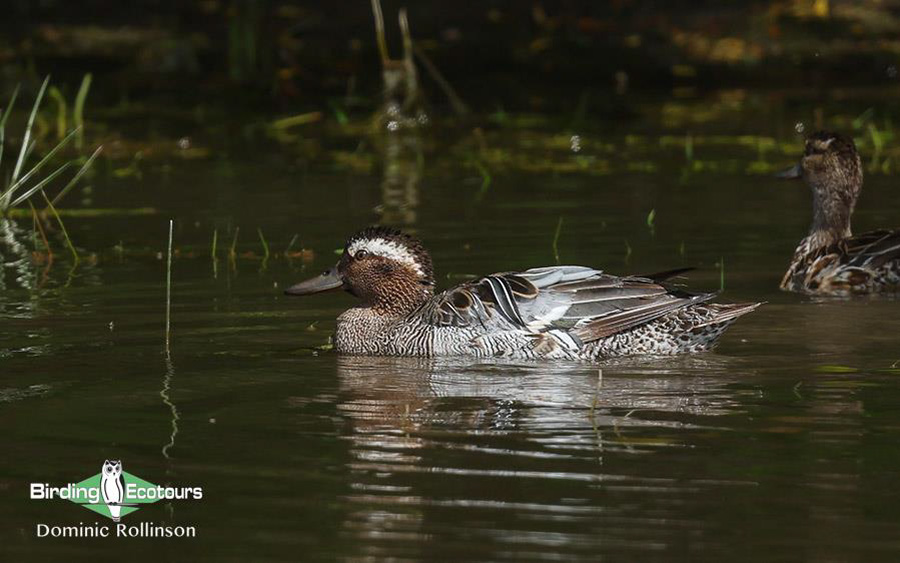
Garganey proved rather abundant and, at times confiding, on this tour.
For our lunch stop we had a picnic on the edge of a salt works which was, of course, full of birds including the likes of Common Shelduck, Greater Flamingo, Black-winged Stilt, Pied Avocet, Black-tailed Godwit, Spotted Redshank, Yellow-legged and Mediterranean Gulls and other regular shorebirds. Another nearby salt works additionally held Grey Plover and Little, Common and Sandwich Terns.
We finished the day birding other nearby lakes around Burgas, which were full of feeding birds. New birds here included Kentish and Common Ringed Plovers and Dunlin. We also enjoyed good long looks at Dalmatian Pelicans, which showed well in the late-afternoon light.
Day 8, 17th May 2024. Northwards along the coast
We had another go for White-backed Woodpecker this morning at Strandzha Nature Park, but did not even hear them calling and thus had to give up with this particular species. Gladly, we did get a showy Marsh Tit. Saying goodbye to Sozopol, we hit the road north, stopping off at a couple of roadside wetlands en route, which added Northern Shoveler, Eurasian Wigeon, Northern Lapwing, Whiskered Tern, White-winged Tern and Common Reed Warbler.
Moving further north, we birded some other wetlands which held Ruddy Shelduck, Common Pheasant, Wood Sandpiper, Glossy Ibis and Eurasian Coot, while the nearby woodlands had Common Nightingale, Spanish Sparrow, Common Linnet and good numbers of Eurasian Turtle Doves. Another nearby marshy area eventually yielded Eurasian Penduline Tit,and Cetti’s Warbler was a bit more obliging than before.
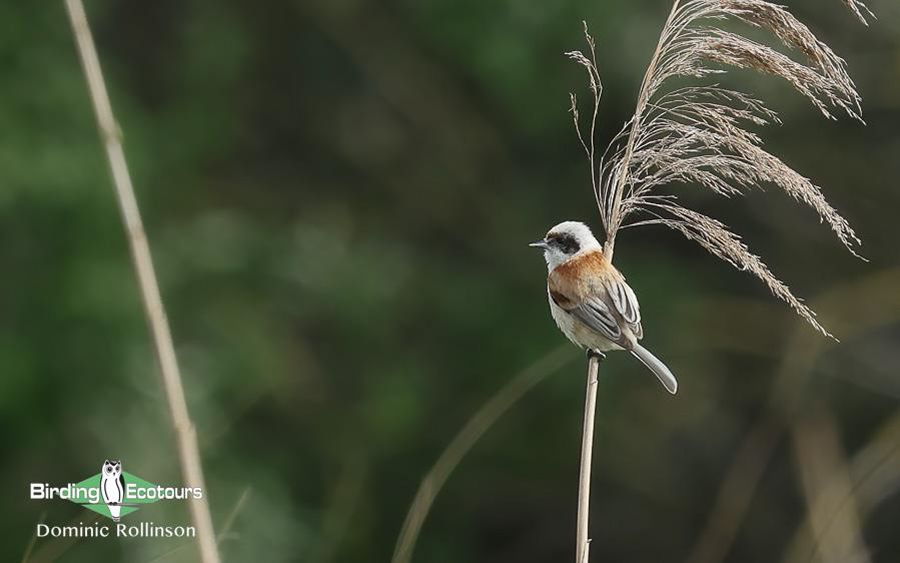
The cute and tiny Eurasian Penduline Tit.
As we traveled north, we made our way through the lower areas of the Balkans Mountains and birded a forested area which finally yielded Semi-collared Flycatcher and Spotted Flycatcher.
In the late afternoon, before getting into Kavarna, we stopped to scan some cliffs for Eurasian Eagle-Owl, which Dancho spotted. While we were searching for the owl, we also added Hawfinch. Melanie was lucky enough to see a European Badger before it disappeared down its burrow, never to be seen again! After a long but incredibly fun and productive day we pulled into Kavarna, where we were based for the next two nights.
Day 9, 18th May 2024. Birding the Kavarna area
We spent the full day birding the various birding sites around Kavarna, moving between coastal steppes, wetlands and the coast itself. We started the day at Cape Kaliakra, which is a great place to watch migrating birds move by, and soon after we arrived we found a number of migrant passerines hanging around. Highlights of our time at Cape Kaliakra included Black-throated Diver, European Shag, Lesser Grey, Red-backed and Woodchat Shrikes, Eurasian Jay, Red-breasted Flycatcher, Whinchat, Northern and Pied Wheatears and Black-headed Bunting.
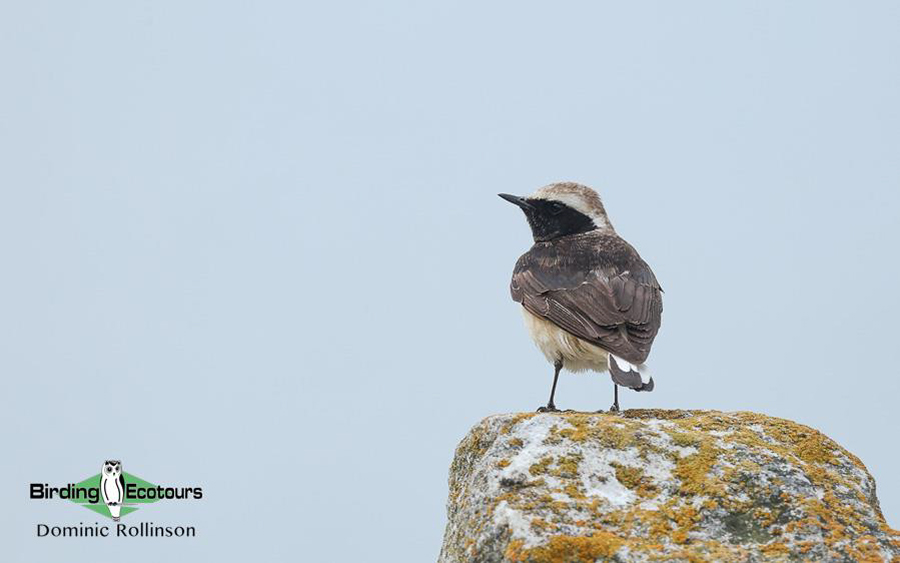
Pied Wheatears were abundant at Cape Kaliakra.
The steppes near Cape Kaliakra were alive with birds and we soon added Greater Short-toed, Calandra and Crested Larks, Woodlark, Isabelline Wheatear, Tawny Pipit and Corn Bunting.
After our lunch stop we birded Lake Durankulak, which further yielded Ferruginous Duck, Caspian Tern, Whiskered Tern and a few Western Marsh Harriers. Before calling it a day, we again stopped at the same steppes as earlier in the day, where we managed to find the hoped-for Eurasian Stone-curlew.
Day 10, 19th May 2024. Crossing into Romania
After our breakfast we again hit the road and kept heading north, and it wasn’t long before we crossed into Romania. Thankfully, the border crossing was very straightforward and took all of around two minutes to get into the country. We quickly added a new bird for the trip, in the form of Rook. It seemed like these birds did not like to cross into Bulgaria, since they were really abundant here but had not been seen until now.
Next stop was Techirghiol Lake, which produced some excellent birding as we drove slowly around the lake. In the open areas surrounding the lake we saw Grey Partridge, Long-legged Buzzard, Rook, Northern Wheatear, Western Yellow Wagtail and also heard Common Quail, which unfortunately would not show. The shoreline was scattered with birds including Black-necked and Great Crested Grebes, Common Moorhen, Grey Plover, Mediterranean Gull, Northern Lapwing, Wood and Curlew Sandpipers, Ruff, Little Stint and we also got lucky with good views of a Pectoral Sandpiper, a rarity in Romania. The highlight of our time around the lake was probably the good numbers of Red-footed Falcons which showed remarkably well for us.
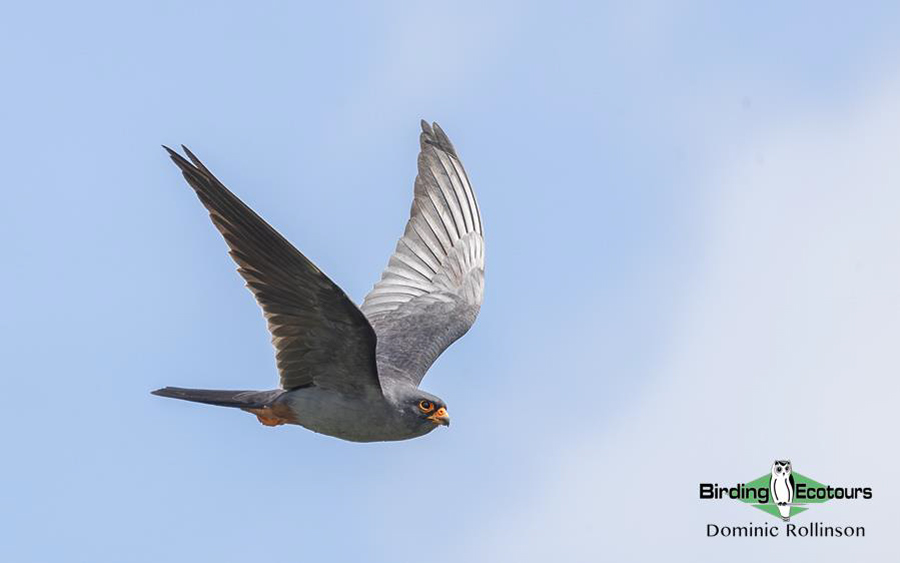
We enjoyed watching Red-footed Falcons hunting dragonflies on the edge of Techirghiol Lake.
We then continued our way north through Romania and birded a quarry where we looked for Rosy Starling, which unfortunately wasn’t around today. Nearby wetlands, however, added Greylag Goose, Ruddy Shelduck, Red-crested Pochard, Little and Pallas’s Gull, Collared Pratincole, Purple Heron, Sand Martin, Moustached Warbler (heard only) and Bearded Reedling.
After another long day out, we caught our boat transfer to our lovely accommodation in the Danube Delta, where we saw our first Caspian Gull of the trip and enjoyed a fine meal that evening.
Day 11, 20th May 2024. Birding the Danube Delta
Excitingly, we had a full day boat trip out on the Danube Delta. We made our way through a complex network of channels and lakes and spent the day working through a broad array of waterfowl and other water birds. Highlights of our boat trip included Garganey, Common and Red-crested Pochard, Ferruginous Duck, Dalmatian and Great White Pelicans, Pygmy Cormorant, Red-necked and Black-necked Grebes, Black-crowned Night Heron, Purple Heron, Great and Little Egrets, Eurasian Spoonbill, Common Redshank, Black, Common and Whiskered Terns, Caspian, Black-headed, Pallas’s and Mediterranean Gulls, Bearded Tit, Western Yellow Wagtail and Common Kingfisher. We also enjoyed watching huge White-tailed Eagles fishing, with Western Marsh Harriers, Red-footed Falcons and Eurasian Hobbies hunting overhead. A stop along the Black Sea coast did not produce too much of interest, besides a few Sandwich and Common Terns passing by.
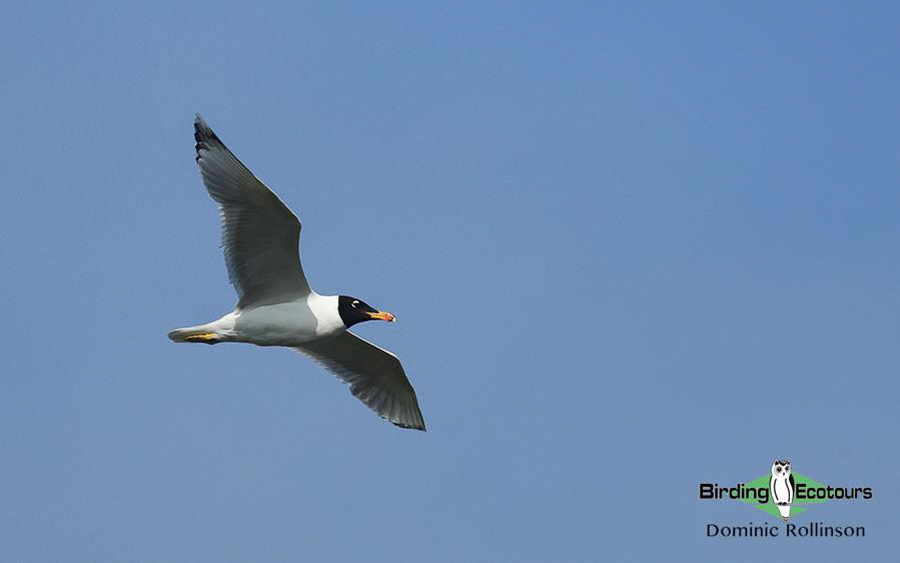
The striking Pallas’s Gull was seen well in Romania.
Day 12, 21st May 2024. Danube Delta to Vadu
This morning Vickie and I took a walk around the lodge grounds and we managed to find a Common Redstart,which was a lifer for Vickie. After breakfast, we caught our water taxi back to our vehicle and then birded our way back south to Vadu, our base for the final day of the tour.
Our first stop was at a large lake and adjoining salt flats which was full of birds, including Common Shelduck, Red-crested and Common Pochards, Black-winged Stilt, Black-headed and Caspian Gulls, Western Marsh Harrier and Red-footed Falcon, with Crested Lark and Western Yellow Wagtail seen on the edges of the lake.
We stopped at the same marsh where we had heard Moustached Warbler a few days ago but, unfortunately, they weren’t even calling today and this species would remain as ‘heard only.’ We did, however, again get good looks at Bearded Reedling here.
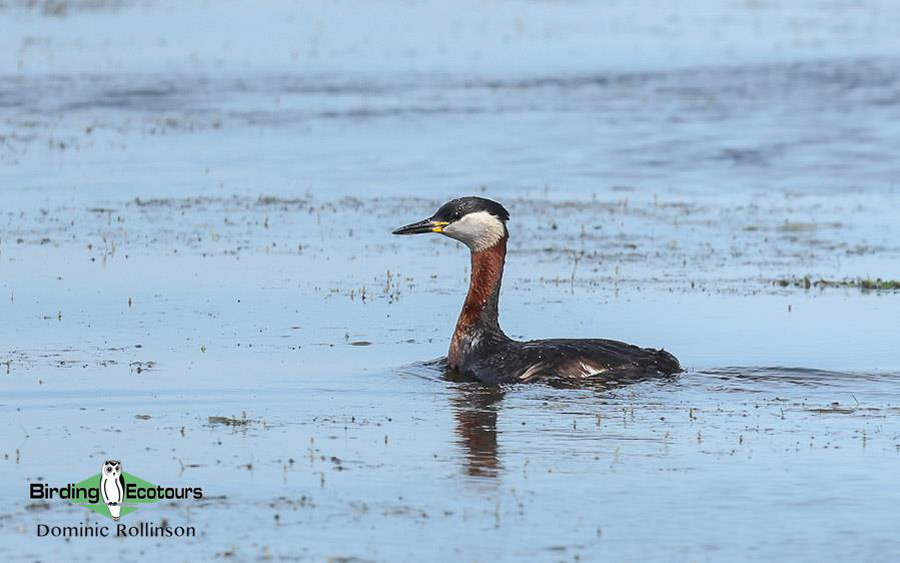
Red-necked Grebes were seen in the lakes of the Danube Delta.
As we continued to make our way south, we stopped in at the impressive Enisala Fortress, which is perched up on an imposing hill. The fortress was built in the 14th century by Genovese merchants who used it to oversee the movement of enemy troops, both at sea and on land. There were some nice birds around here, such as Great Egret, European Bee-eater, Northern Wheatear and White Wagtail.
Our lunch stop was a very pleasant picnic lunch along the edge of Lake Razim, with Bearded Reedlings moving between reedbeds. Here, we also saw a couple of large Tessellated Water Snakes, nonvenomous snakes which often feed on fish!
In the early afternoon we birded some marshy areas near Lake Sinoe, finding the hoped-for Paddyfield Warbler, as well as a good selection of water birds such as Kentish Plover, Spotted Redshank, Ruff, Little Stint, Collared Pratincole and Great White Pelican. In the surrounding farmland we encountered Common Kestrel, Red-footed Falcon, Long-legged Buzzard and Western Marsh Harrier.
For our final birding of the day, we birded the vast network of lakes, ponds, channels and reedbeds around Vadu. This area is one of Romania’s most popular birding spots and, after the afternoon birding here, we could clearly see why. Over the course of our couple hours here, we found many exciting species, such as Garganey, Eurasian Teal, Common Pochard, Black-tailed Godwit, Common Redshank, Curlew Sandpiper, Little Gull, Eurasian Bittern, Black-crowned Night Heron, Squacco and Purple Herons, Eurasian Spoonbill, Red-footed Falcon, Woodlark, Bearded Tit, Paddyfield, Common Reed, Garden and Savi’s Warblers, Whinchat and Common Reed Bunting. A sure highlight was hearing Eurasian Bitterns booming right nearby us, and we managed to see a couple birds flying low over the reedbeds, capping off another fantastic day. Our final night was in a lovely hotel, right on the edge of town, overlooking wheatfields, with Common Quail calling away (but, of course, not revealing themselves).
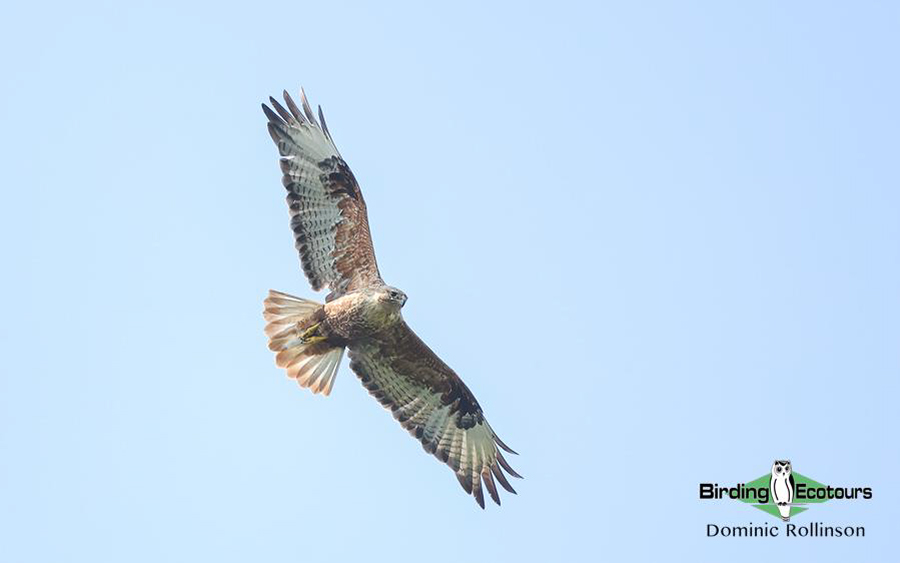
Long-legged Buzzards were widespread in Bulgaria and Romania.
Day 13, 22nd May 2024. Vadu birding and departure from Bucharest
For our final day in Romania, we enjoyed some early morning birding around Vadu’s wetlands which produced more of the same as yesterday, as well as slightly improved views of Eurasian Bittern and Savi’s Warbler.
It was then time to hit the road and head west towards the Romanian capital, Bucharest. We still had some time for birding in the late morning. We had a productive final stop in some woodlands and farmlands, which added the likes of Long-legged Buzzard, Eurasian Hoopoe, Syrian Woodpecker, Eurasian Tree Sparrow and the highlight of the morning, Levant Sparrowhawk (well-spotted by Vickie).
Our roughly two weeks in the Balkans ended with drop-offs at Bucharest Airport, where we said our goodbyes. Thanks to Dancho for his expert guiding and navigation and to Vickie and Melanie for making this trip a thoroughly enjoyable one! Look forward to traveling with you both again soon!
Bird List – Following IOC (December 2023)
Birds ‘heard only’ are marked with (H) after the common name, all other species were seen both by clients and guide.
The following notation after species names is used to show conservation status following BirdLife International. EN = Endangered, VU = Vulnerable.
| Common name | Scientific name |
| Ducks, Geese, Swans (Anatidae) | |
| Greylag Goose | Anser anser |
| Mute Swan | Cygnus olor |
| Common Shelduck | Tadorna tadorna |
| Ruddy Shelduck | Tadorna ferruginea |
| Garganey | Spatula querquedula |
| Northern Shoveler | Spatula clypeata |
| Gadwall | Mareca strepera |
| Eurasian Wigeon | Mareca penelope |
| Mallard | Anas platyrhynchos |
| Eurasian Teal | Anas crecca |
| Red-crested Pochard | Netta rufina |
| Common Pochard – VU | Aythya ferina |
| Ferruginous Duck | Aythya nyroca |
| Pheasants & Allies (Phasianidae) | |
| Grey Partridge | Perdix perdix |
| Common Pheasant | Phasianus colchicus |
| Common Quail (H) | Coturnix coturnix |
| Chukar Partridge | Alectoris chukar |
| Swifts (Apodidae) | |
| Alpine Swift | Tachymarptis melba |
| Common Swift | Apus apus |
| Pallid Swift | Apus pallidus |
| Cuckoos (Cuculidae) | |
| Common Cuckoo | Cuculus canorus |
| Pigeons, Doves (Columbidae) | |
| Rock Dove | Columba livia |
| Common Wood Pigeon | Columba palumbus |
| European Turtle Dove – VU | Streptopelia turtur |
| Eurasian Collared Dove | Streptopelia decaocto |
| Rails, Crakes & Coots (Rallidae) | |
| Corn Crake | Crex crex |
| Common Moorhen | Gallinula chloropus |
| Eurasian Coot | Fulica atra |
| Grebes (Podicipedidae) | |
| Little Grebe | Tachybaptus ruficollis |
| Red-necked Grebe | Podiceps grisegena |
| Great Crested Grebe | Podiceps cristatus |
| Black-necked Grebe | Podiceps nigricollis |
| Flamingos (Phoenicopteridae) | |
| Greater Flamingo | Phoenicopterus roseus |
| Stone-curlews, Thick-knees (Burhinidae) | |
| Eurasian Stone-curlew | Burhinus oedicnemus |
| Oystercatchers (Haematopodidae) | |
| Eurasian Oystercatcher | Haematopus ostralegus |
| Stilts, Avocets (Recurvirostridae) | |
| Black-winged Stilt | Himantopus himantopus |
| Pied Avocet | Recurvirostra avosetta |
| Plovers (Charadriidae) | |
| Grey Plover | Pluvialis squatarola |
| Common Ringed Plover | Charadrius hiaticula |
| Little Ringed Plover | Charadrius dubius |
| Northern Lapwing | Vanellus vanellus |
| Kentish Plover | Anarhynchus alexandrinus |
| Sandpipers, Snipes (Scolopacidae) | |
| Black-tailed Godwit | Limosa limosa |
| Common Sandpiper | Actitis hypoleucos |
| Wood Sandpiper | Tringa glareola |
| Common Redshank | Tringa totanus |
| Spotted Redshank | Tringa erythropus |
| Ruff | Calidris pugnax |
| Curlew Sandpiper | Calidris ferruginea |
| Sanderling | Calidris alba |
| Dunlin | Calidris alpina |
| Little Stint | Calidris minuta |
| Pectoral Sandpiper | Calidris melanotos |
| Coursers, Pratincoles (Glareolidae) | |
| Collared Pratincole | Glareola pratincola |
| Gulls, Terns, Skimmers (Laridae) | |
| Little Tern | Sternula albifrons |
| Caspian Tern | Hydroprogne caspia |
| Whiskered Tern | Chlidonias hybrida |
| Black Tern | Chlidonias niger |
| White-winged Tern | Chlidonias leucopterus |
| Common Tern | Sterna hirundo |
| Sandwich Tern | Thalasseus sandvicensis |
| Little Gull | Hydrocoloeus minutus |
| Black-headed Gull | Chroicocephalus ridibundus |
| Pallas’s Gull | Ichthyaetus ichthyaetus |
| Mediterranean Gull | Ichthyaetus melanocephalus |
| Caspian Gull | Larus cachinnans |
| Yellow-legged Gull | Larus michahellis |
| Loons (Gaviidae) | |
| Black-throated Loon | Gavia arctica |
| Storks (Ciconiidae) | |
| Black Stork | Ciconia nigra |
| White Stork | Ciconia ciconia |
| Cormorants, Shags (Phalacrocoracidae) | |
| Pygmy Cormorant | Microcarbo pygmaeus |
| Great Cormorant | Phalacrocorax carbo |
| European Shag | Gulosus aristotelis |
| Ibises, Spoonbills (Threskiornithidae) | |
| Glossy Ibis | Plegadis falcinellus |
| Eurasian Spoonbill | Platalea leucorodia |
| Herons, Bitterns (Ardeidae) | |
| Eurasian Bittern | Botaurus stellaris |
| Little Bittern | Ixobrychus minutus |
| Black-crowned Night Heron | Nycticorax nycticorax |
| Little Egret | Egretta garzetta |
| Squacco Heron | Ardeola ralloides |
| Great Egret | Ardea alba |
| Grey Heron | Ardea cinerea |
| Purple Heron | Ardea purpurea |
| Pelicans (Pelecanidae) | |
| Great White Pelican | Pelecanus onocrotalus |
| Dalmatian Pelican | Pelecanus crispus |
| Kites, Hawks, Eagles (Accipitridae) | |
| Egyptian Vulture – EN | Neophron percnopterus |
| European Honey Buzzard | Pernis apivorus |
| Griffon Vulture | Gyps fulvus |
| Cinereous Vulture | Aegypius monachus |
| Short-toed Snake Eagle | Circaetus gallicus |
| Lesser Spotted Eagle | Clanga pomarina |
| Booted Eagle | Hieraaetus pennatus |
| Eastern Imperial Eagle – VU | Aquila heliaca |
| Levant Sparrowhawk | Accipiter brevipes |
| Eurasian Sparrowhawk | Accipiter nisus |
| Western Marsh Harrier | Circus aeruginosus |
| Black Kite | Milvus migrans |
| White-tailed Eagle | Haliaeetus albicilla |
| Long-legged Buzzard | Buteo rufinus |
| Common Buzzard | Buteo buteo |
| Owls (Strigidae) | |
| Little Owl | Athene noctua |
| Eurasian Scops Owl | Otus scops |
| Eurasian Eagle-Owl | Bubo bubo |
| Hoopoes (Upupidae) | |
| Eurasian Hoopoe | Upupa epops |
| Rollers (Coraciidae) | |
| European Roller | Coracias garrulus |
| Kingfishers (Alcedinidae) | |
| Common Kingfisher | Alcedo atthis |
| Bee-eaters (Meropidae) | |
| European Bee-eater | Merops apiaster |
| Woodpeckers (Picidae) | |
| Eurasian Wryneck (H) | Jynx torquilla |
| Middle Spotted Woodpecker | Dendrocoptes medius |
| Lesser Spotted Woodpecker | Dryobates minor |
| Syrian Woodpecker | Dendrocopos syriacus |
| Great Spotted Woodpecker | Dendrocopos major |
| White-backed Woodpecker (H) | Dendrocopos leucotos |
| Black Woodpecker | Dryocopus martius |
| European Green Woodpecker | Picus viridis |
| Grey-headed Woodpecker | Picus canus |
| Caracaras, Falcons (Falconidae) | |
| Lesser Kestrel | Falco naumanni |
| Common Kestrel | Falco tinnunculus |
| Red-footed Falcon – VU | Falco vespertinus |
| Eurasian Hobby | Falco subbuteo |
| Peregrine Falcon | Falco peregrinus |
| Figbirds, Old World Orioles, Piopios (Oriolidae) | |
| Eurasian Golden Oriole | Oriolus oriolus |
| Shrikes (Laniidae) | |
| Masked Shrike | Lanius nubicus |
| Lesser Grey Shrike | Lanius minor |
| Woodchat Shrike | Lanius senator |
| Red-backed Shrike | Lanius collurio |
| Crows, Jays (Corvidae) | |
| Eurasian Jay | Garrulus glandarius |
| Eurasian Magpie | Pica pica |
| Spotted Nutcracker (H) | Nucifraga caryocatactes |
| Western Jackdaw | Coloeus monedula |
| Rook | Corvus frugilegus |
| Hooded Crow | Corvus cornix |
| Northern Raven | Corvus corax |
| Tits, Chickadees (Paridae) | |
| Coal Tit | Periparus ater |
| Crested Tit | Lophophanes cristatus |
| Sombre Tit | Poecile lugubris |
| Marsh Tit | Poecile palustris |
| Willow Tit | Poecile montanus |
| Eurasian Blue Tit | Cyanistes caeruleus |
| Great Tit | Parus major |
| Penduline Tits (Remizidae) | |
| Eurasian Penduline Tit | Remiz pendulinus |
| Bearded Reedling (Panuridae) | |
| Bearded Reedling | Panurus biarmicus |
| Larks (Alaudidae) | |
| Woodlark | Lullula arborea |
| Eurasian Skylark | Alauda arvensis |
| Crested Lark | Galerida cristata |
| Greater Short-toed Lark | Calandrella brachydactyla |
| Calandra Lark | Melanocorypha calandra |
| Swallows, Martins (Hirundinidae) | |
| Sand Martin | Riparia riparia |
| Eurasian Crag Martin | Ptyonoprogne rupestris |
| Barn Swallow | Hirundo rustica |
| Western House Martin | Delichon urbicum |
| Red-rumped Swallow | Cecropis daurica |
| Cettia Bush Warblers & Allies (Cettiidae) | |
| Cetti’s Warbler | Cettia cetti |
| Bushtits (Aegithalidae) | |
| Long-tailed Tit | Aegithalos caudatus |
| Leaf Warblers (Phylloscopidae) | |
| Willow Warbler (H) | Phylloscopus trochilus |
| Common Chiffchaff | Phylloscopus collybita |
| Reed Warblers & Allies (Acrocephalidae) | |
| Great Reed Warbler | Acrocephalus arundinaceus |
| Moustached Warbler (H) | Acrocephalus melanopogon |
| Paddyfield Warbler | Acrocephalus agricola |
| Common Reed Warbler | Acrocephalus scirpaceus |
| Marsh Warbler | Acrocephalus palustris |
| Eastern Olivaceous Warbler | Iduna pallida |
| Olive-tree Warbler | Hippolais olivetorum |
| Icterine Warbler | Hippolais icterina |
| Grassbirds & Allies (Locustellidae) | |
| Savi’s Warbler | Locustella luscinioides |
| Sylviid Babblers (Sylviidae) | |
| Eurasian Blackcap | Sylvia atricapilla |
| Garden Warbler | Sylvia borin |
| Barred Warbler | Curruca nisoria |
| Lesser Whitethroat | Curruca curruca |
| Eastern Orphean Warbler | Curruca crassirostris |
| Sardinian Warbler | Curruca melanocephala |
| Eastern Subalpine Warbler | Curruca cantillans |
| Common Whitethroat | Curruca communis |
| Goldcrests, Kinglets (Regulidae) | |
| Common Firecrest | Regulus ignicapilla |
| Goldcrest | Regulus regulus |
| Wrens (Troglodytidae) | |
| Eurasian Wren | Troglodytes troglodytes |
| Nuthatches (Sittidae) | |
| Eurasian Nuthatch | Sitta europaea |
| Wallcreeper (Tichodromidae) | |
| Wallcreeper | Tichodroma muraria |
| Treecreepers (Certhiidae) | |
| Eurasian Treecreeper | Certhia familiaris |
| Short-toed Treecreeper | Certhia brachydactyla |
| Starlings, Rhabdornises (Sturnidae) | |
| Common Starling | Sturnus vulgaris |
| Thrushes (Turdidae) | |
| Song Thrush | Turdus philomelos |
| Mistle Thrush | Turdus viscivorus |
| Common Blackbird | Turdus merula |
| Ring Ouzel | Turdus torquatus |
| Chats, Old World Flycatchers (Muscicapidae) | |
| Spotted Flycatcher | Muscicapa striata |
| European Robin | Erithacus rubecula |
| Common Nightingale | Luscinia megarhynchos |
| Red-breasted Flycatcher | Ficedula parva |
| Semicollared Flycatcher | Ficedula semitorquata |
| Black Redstart | Phoenicurus ochruros |
| Common Redstart | Phoenicurus phoenicurus |
| Blue Rock Thrush | Monticola solitarius |
| Whinchat | Saxicola rubetra |
| European Stonechat | Saxicola rubicola |
| Northern Wheatear | Oenanthe oenanthe |
| Isabelline Wheatear | Oenanthe isabellina |
| Pied Wheatear | Oenanthe pleschanka |
| Eastern Black-eared Wheatear | Oenanthe melanoleuca |
| Dippers (Cinclidae) | |
| White-throated Dipper | Cinclus cinclus |
| Old World Sparrows, Snowfinches (Passeridae) | |
| Eurasian Tree Sparrow | Passer montanus |
| Spanish Sparrow | Passer hispaniolensis |
| House Sparrow | Passer domesticus |
| Accentors (Prunellidae) | |
| Dunnock | Prunella modularis |
| Wagtails, Pipits (Motacillidae) | |
| Western Yellow Wagtail | Motacilla flava |
| Grey Wagtail | Motacilla cinerea |
| White Wagtail | Motacilla alba |
| Tawny Pipit | Anthus campestris |
| Finches, Euphonias (Fringillidae) | |
| Eurasian Chaffinch | Fringilla coelebs |
| Hawfinch | Coccothraustes coccothraustes |
| Eurasian Bullfinch | Pyrrhula pyrrhula |
| European Greenfinch | Chloris chloris |
| Common Linnet | Linaria cannabina |
| Red Crossbill | Loxia curvirostra |
| European Goldfinch | Carduelis carduelis |
| European Serin | Serinus serinus |
| Buntings (Emberizidae) | |
| Corn Bunting | Emberiza calandra |
| Yellowhammer | Emberiza citrinella |
| Rock Bunting | Emberiza cia |
| Ortolan Bunting | Emberiza hortulana |
| Cirl Bunting | Emberiza cirlus |
| Black-headed Bunting | Emberiza melanocephala |
| Common Reed Bunting | Emberiza schoeniclus |
| Species Seen | 217 |
| Species heard only | 6 |
| Total species recorded | 223 |
Mammal List – Following Mammalwatching.com
| Common name | Scientific name |
| Hares and Rabbits (Leporidae) | |
| European Hare | Lepus europaeus |
| Spiny Rats and Hutias (Echimyidae) | |
| Coypu | Myocastor coypus |
| Squirrels (Sciuridae) | |
| Eurasian Red Squirrel | Sciurus vulgaris |
| European Ground Squirrel (Souslik) | Spermophilus citellus |
| Canids (Canidae) | |
| Red Fox | Vulpes vulpes |
| Bovids (Bovidae) | |
| Northern Chamois | Rupicapra rupicapra |
| Deer (Cervidae) | |
| Western Roe Deer | Capreolus capreolus |
| Common Fallow Deer | Dama dama |
| Porpoises (Phocoenidae) | |
| Harbor Porpoise | Phocoena phocoena |
| Species Seen | 9 |
Reptiles List – Following Mammalwatching.com
| Common name | Scientific name |
| Colubrid Snakes (Colubridae) | |
| Tessellated Water Snake | Natrix tessellata |
| Wall Lizards (Lacertidae) | |
| Meadow Lizard | Darevskia praticola |
| Pond and Box Turtles (Emydidae) | |
| European Pond Turtle | Emys orbicularis |
| Tortoises (Testudinidae) | |
| Greek Tortoise – VU | Testudo graeca |
| Species seen: | 4 |
This is a sample trip report. Please email us ([email protected]) for more trip reports from this destination.
